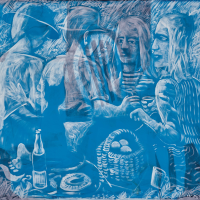22. CHARLES BLACKMAN

This tapestry-sized painting of a picnic outing harks back to douard Manets Le Djeuner sur l'Herbe 1863 (Muse d'Orsay collection, Paris) and to deeply personal memories of Blackmans family life.
His first wife, the poet Barbara Blackman, who also was the model for his famous Alice in Wonderland paintings, sits on the right turning into the space. Her feeling arms are clawed as they reach towards the picnic basket and the arm of one of her three children.
The painting resembles a photographic negative, an image fading, almost lost in time; perhaps the bittersweet memories of a once shared past. The reflections of a dining chair, the blue stocking legs of one of the children pushing ever upwards and an extra hand waving at the viewer suggests echoes of happier family days. And as a snapshot it is a summary of Blackmans feelings during the early 1980s when the reality of his recent divorce from Barbara (who resigned from the marriage) had hit home.
Blackman painted this unique work after living in Paris and London and absorbing real handmade works of art and the richness of the European tradition. But as always with Blackmans work his ability to reference and learn from the masters is intermingled with his own emotional and environmental surroundings. The foliage in the background of this work is reminiscent of his new studio (and new wife) in Buderim, North Queensland. His three and a quarter acres of land became a welcome winter studio; beneath the tangled lantana he finds a buried garden with jasmine, coach wood trees, leopard trees and its very own carpet snake. This paradise garden became Blackmans own Garden of Eden.
The cut-out shadow in the foreground of a cat refers to another of Blackmans series of paintings the White Cats Garden paintings from the late 1970s. The Blackmans always owned cats; they were part of the family; and just as they wandered in and out of the various Blackman houses through the ever-open bathroom window, their figures slink, slide and stalk Blackmans oeuvre.
The silence in The Blue Picnic is palpable. One feels a sense of reverence and admiration, not only at the sheer size of this work but also at the way Blackman tenderly strokes out his children and ex-wife with a loose, fast brush, gently decorating their bodies with passages of dusty pinkish patterning. Although the father/artist figure is absent from the scene, you can feel his heart pouring into the surface as two of his children turn away from him into the idyllic tropical landscape.
The painting also recalls Blackmans autobiographical works of the mid 1970s exhibited at Brisbanes Johnstone Gallery where he painted three large memory pictures on very dark grounds on the theme of A Time Remembered. These works centred on musical themes and were later donated by Sony to the Sydney Opera House, negotiated by the music critic and author Nadine Amadio.
The sources of Blackmans late works lie firmly in the Symbolist movement of the late 19th century in the quest for a synthesis of the arts. That aesthetic ideal, embracing the idea of artistic creation as the ultimate mystery and value with its corollary, of art as a way of life, always informed Blackman, ever since his early days as a member of John and Sunday Reeds artistic circle at Heide.
Felicity St John Moore